Losing a hand or part of your arm can be life-changing, but modern prosthetics offer a way to regain independence and confidence. If you or a loved one is considering a prosthetic hand or arm, understanding the fitment process is the first step. Many people worry about whether a prosthetic will be comfortable, easy to use, or even worth the effort. The good news is that today’s prosthetics, like Grippy™ by Robobionics, are designed to be lightweight, ergonomic, and adaptable to your lifestyle.
The fitment process is not just about getting a new hand—it’s about making sure it feels right, works well, and helps you do the things you love. Whether you are new to prosthetics or looking for a better fit, this guide will walk you through everything you need to know.
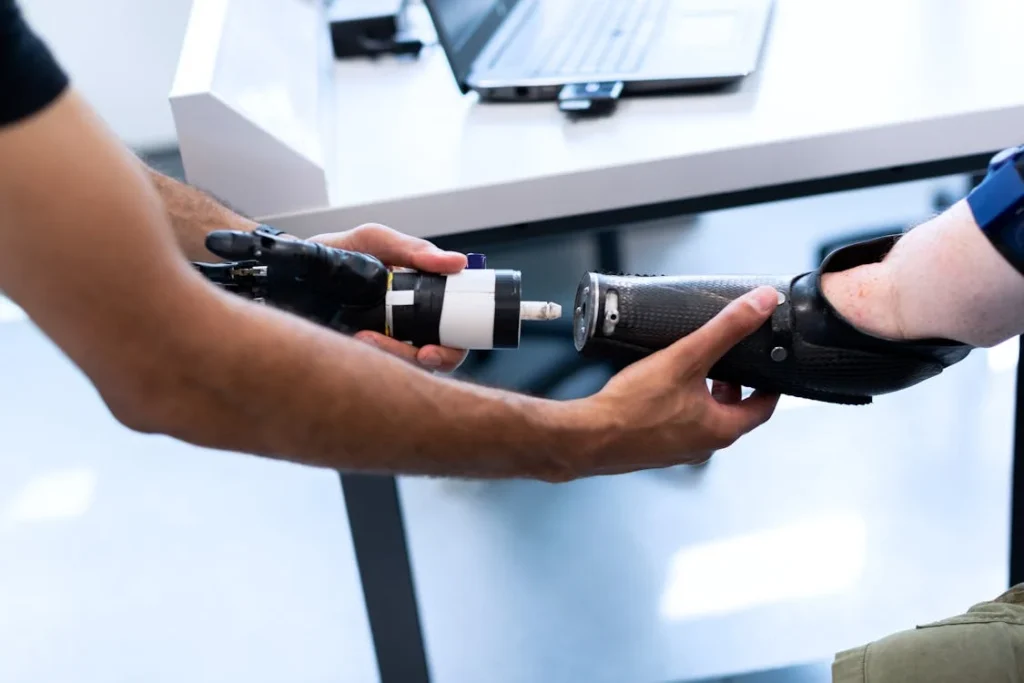
What Is Prosthetic Fitment?
Prosthetic fitment is the process of selecting, customizing, and adjusting a prosthetic limb so that it fits comfortably and functions properly.
It’s not a one-size-fits-all solution. Each prosthetic is tailored to the person’s unique limb shape, lifestyle, and goals.
A well-fitted prosthetic does more than just look good—it helps restore movement, improves balance, and reduces strain on the rest of your body.
The goal is to make sure the prosthetic feels as natural as possible, allowing you to carry out daily tasks with ease.
How the Prosthetic Fitment Process Works
The fitment process has several stages. Each step ensures that the prosthetic is comfortable, functional, and meets your needs. Let’s break it down.
1. Initial Consultation and Evaluation
The journey begins with an evaluation by a prosthetist—a specialist who designs and fits artificial limbs.
During this consultation, the prosthetist will assess your residual limb, overall health, and daily activities. They’ll ask questions like:
- What tasks do you want to do with your prosthetic?
- Do you prefer a cosmetic prosthetic or one with functional movement?
- How active is your lifestyle?
The goal is to find the right prosthetic type for your needs. For instance, some people may need a myoelectric hand, which responds to muscle signals, while others might prefer a body-powered option that uses cables and harnesses.
At Robobionics, we offer free demos to help you explore different options and understand how a prosthetic can work for you. Book a free demo of Grippy™ now and experience the difference!
2. Taking Measurements and Making a Prosthetic Socket
Once you’ve chosen the right prosthetic type, the next step is creating a socket—the part that connects your limb to the prosthetic.
A well-made socket ensures comfort and stability.
A prosthetist will take a precise mold or digital scan of your residual limb. This helps in designing a socket that fits snugly without causing pain or pressure points.
Modern materials, such as lightweight carbon fiber and soft silicone liners, help improve comfort and reduce skin irritation.
3. Testing and Trial Period
Before finalizing the prosthetic, a temporary test socket is created. This allows you to wear the prosthetic and provide feedback on how it feels. If anything feels too tight or loose, adjustments are made.
During this phase, rehabilitation plays a crucial role. Robobionics offers home-based gamified rehab programs that help you adapt to your prosthetic in a fun and engaging way.
This makes the learning process smoother and helps you regain control faster. Learn how gamified rehabilitation can improve your prosthetic experience. Contact us today!
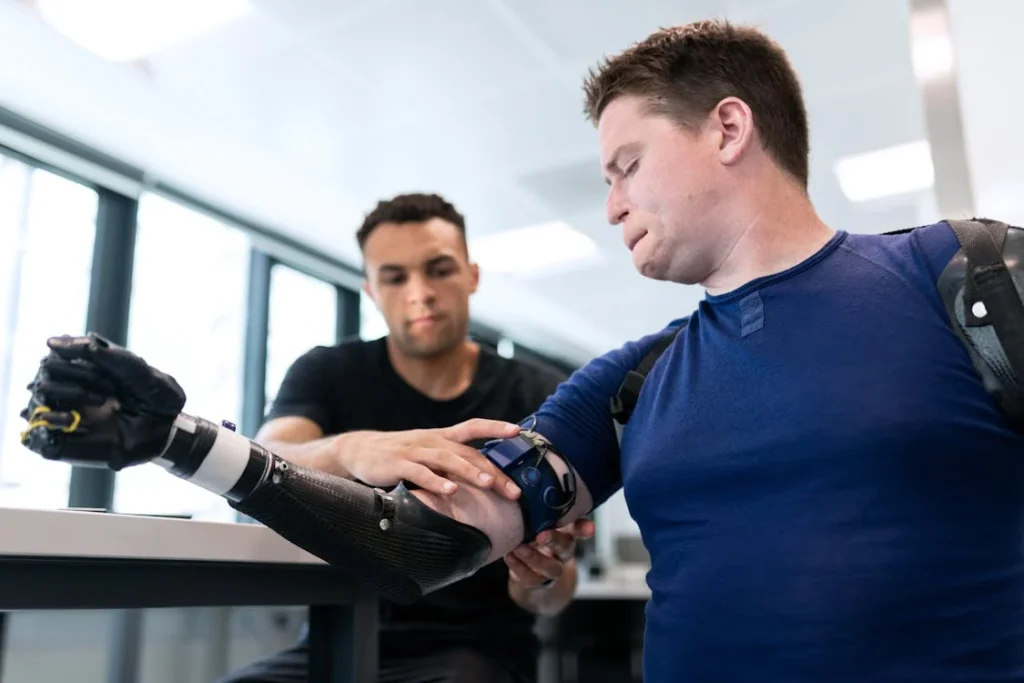
Understanding the Final Fit and Adjustments
Once the initial testing phase is complete, the prosthetist moves forward with creating the final prosthetic. This is a crucial stage because even the smallest adjustment can make a big difference in comfort and usability.
The final prosthetic is designed based on all the feedback gathered during the trial period. It is made with high-quality materials that are durable, lightweight, and suited to your specific needs.
The Importance of a Perfect Fit
A prosthetic should feel like an extension of your body. If it’s too loose, it may slip or cause discomfort.
If it’s too tight, it can lead to pressure sores or restricted movement. This is why the fitting process involves multiple adjustments to ensure a snug yet comfortable fit.
The socket, which connects your limb to the prosthetic, plays a key role in this. It should distribute pressure evenly across your residual limb to prevent pain and discomfort.
A common issue that many amputees face is volume fluctuation in the residual limb. Throughout the day, your limb may swell or shrink slightly due to factors like temperature, activity level, or even diet.
This is normal, but it means that minor adjustments may be needed over time. Some prosthetics come with adjustable liners or padding that help accommodate these changes.
Your prosthetist will guide you on how to manage such fluctuations so that your prosthetic remains comfortable throughout the day.
Getting Used to Your Prosthetic
Wearing a prosthetic for the first time can feel strange. It takes time for your brain and body to adjust.
Some people feel an immediate sense of relief and capability, while others may need a longer adaptation period. Either way, patience and consistency are key.
At first, you may need to wear your prosthetic for short periods, gradually increasing the duration as your body adapts.
This prevents unnecessary strain and allows your skin to get used to the new contact points.
Any signs of redness, pain, or discomfort should be discussed with your prosthetist immediately so that adjustments can be made.
It’s also important to practice simple movements before taking on more complex tasks.
Start with basic activities like picking up light objects, gripping a cup, or using your prosthetic to support everyday tasks like dressing.
As your comfort and confidence grow, you can move on to more advanced movements that fit your lifestyle, whether it’s typing on a keyboard, cooking, or even engaging in sports.
The Role of Rehabilitation in Fitment
A prosthetic hand or arm is only as good as the training and rehabilitation that comes with it.
Even if a prosthetic is designed to be highly advanced, it still requires effort and practice to use effectively. This is why rehabilitation is an essential part of the fitment process.
At Robobionics, we emphasize gamified home-based rehabilitation to make this process engaging and stress-free.
These programs help users develop control, coordination, and strength in a way that feels natural and enjoyable.
Instead of traditional exercises, gamified rehab allows you to interact with digital interfaces, making the learning process fun and rewarding.
Through consistent training, you will develop better muscle memory, making your prosthetic feel more intuitive.
Over time, actions that once required conscious effort will become second nature. This is especially important for myoelectric prosthetics, which rely on muscle signals to function.
The more you train, the more responsive and efficient your prosthetic will become.
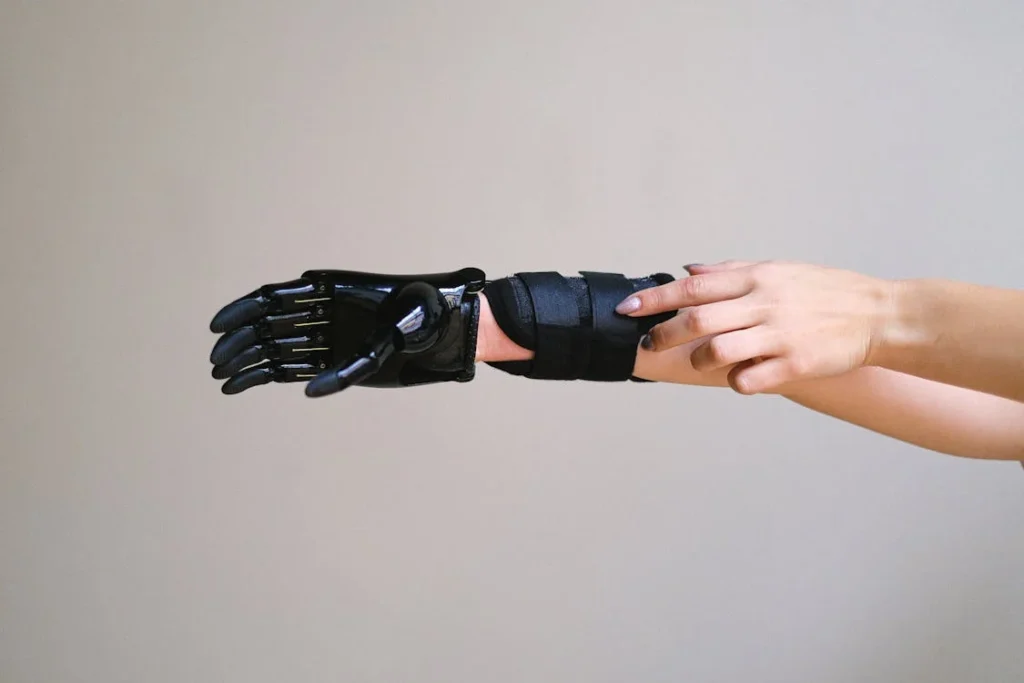
Overcoming Common Challenges with Prosthetic Fitment
Getting a prosthetic is an empowering journey, but like any adjustment, it comes with challenges.
Many first-time users face issues like discomfort, difficulty with movement, or even emotional barriers. These are normal, and the right approach can help make the transition smoother.
Managing Discomfort and Skin Irritation
One of the most common concerns among new prosthetic users is skin irritation. Since the prosthetic socket is in constant contact with your residual limb, friction and pressure can sometimes cause redness or soreness.
This is why choosing the right fit and materials is so important. Soft liners, breathable materials, and well-designed sockets help minimize discomfort.
It’s also essential to maintain proper hygiene. Keeping your residual limb clean and dry prevents skin infections or rashes.
Washing the socket liner daily with mild soap and water can also help reduce irritation. If you notice persistent pain or pressure sores, your prosthetist can adjust the socket for a better fit.
Swelling is another issue that can affect comfort. Changes in limb size due to weather, physical activity, or even hydration levels can make the socket feel too tight or too loose.
If this happens frequently, your prosthetist might recommend using adjustable socket liners or adding padding to improve the fit.
Building Confidence and Muscle Strength
Beyond physical adjustments, using a prosthetic also requires emotional and mental adaptation. Many people feel frustrated in the beginning, especially when performing tasks that once felt effortless.
It’s important to remember that learning to use a prosthetic is like training a new muscle—it takes time, patience, and regular practice. Rehabilitation exercises help strengthen the muscles that control your prosthetic.
Even for body-powered prosthetics, where movement is driven by cables and harnesses, consistent practice improves strength and coordination.
Myoelectric prosthetics require even more training, as your brain and muscles need to develop control over the electronic signals that move the prosthetic fingers.
Many users find that setting small, achievable goals makes a big difference. Instead of expecting to do everything perfectly right away, focus on mastering one task at a time.
Start with simple movements like opening and closing the hand, gripping light objects, or stabilizing items with your prosthetic.
As your confidence grows, you’ll be able to take on more complex activities.
Emotional Adjustment and Support
Adapting to a prosthetic isn’t just a physical process—it’s an emotional one too. Some people experience frustration or self-consciousness, especially in social situations.
It’s completely normal to feel this way, and the best way to overcome these feelings is through support and encouragement.
Many amputees find comfort in connecting with others who have gone through similar experiences.
Support groups, online communities, and peer mentorship programs can provide valuable advice, encouragement, and a sense of belonging.
At Robobionics, we believe that no one should go through this journey alone. That’s why we work closely with rehabilitation specialists and community groups to help new users adapt with confidence.
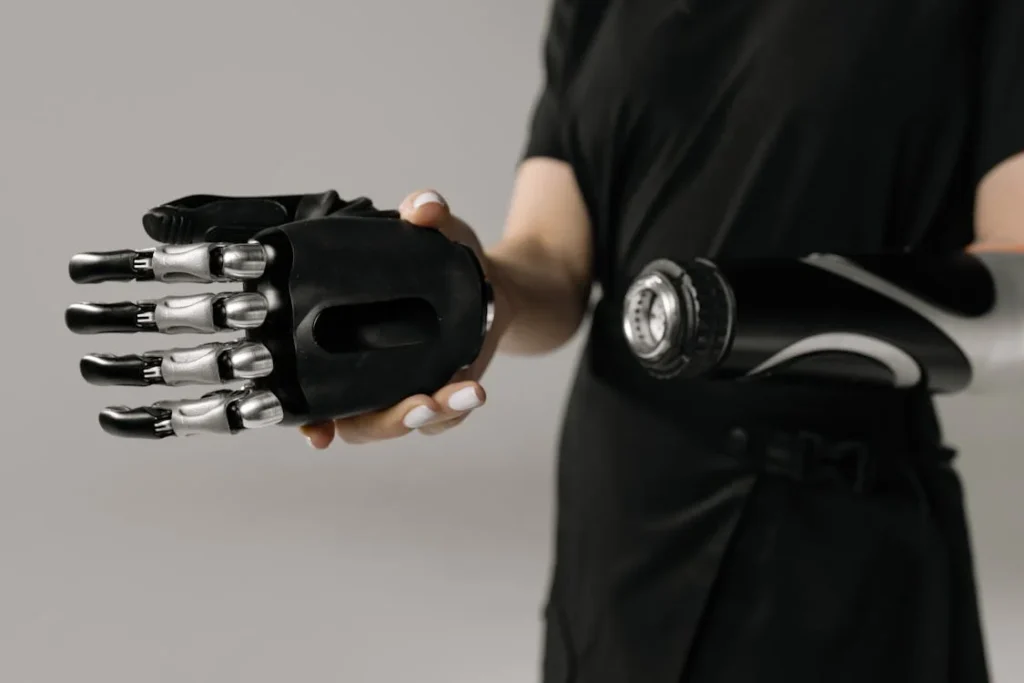
Daily Life with a Prosthetic Hand
Once your prosthetic is properly fitted and adjusted, the next step is integrating it into your daily life.
The goal is to make it feel like a natural part of you, something that helps you regain control and independence.
At first, using a prosthetic may require conscious effort, but with time, it will become second nature.
Getting Comfortable with Everyday Activities
Simple tasks like brushing your teeth, holding a cup, or buttoning a shirt may feel different with a prosthetic hand.
The key is repetition. The more you practice these movements, the easier they become.
Many users start by using their prosthetic for basic support—holding objects steady while using their other hand to perform the task.
Over time, they gradually begin using their prosthetic for more active movements, like gripping, pinching, and lifting.
For those using myoelectric prosthetics, it’s important to train your muscles to send the right signals.
Myoelectric hands respond to tiny electrical signals from your muscles, so practicing small, controlled movements helps improve precision.
If you have a body-powered prosthetic, getting used to the harness system and understanding how different body motions control the hand will take some adjustment.
At first, certain movements may feel awkward or unnatural, but this is a normal part of the process.
Your brain and body need time to rewire themselves to accommodate the prosthetic.
The best way to speed up this adaptation is to incorporate your prosthetic into your daily routine as much as possible.
Handling Different Types of Objects
One challenge many new prosthetic users face is understanding how much force to apply when gripping objects.
Unlike a natural hand, a prosthetic does not have sensory feedback, meaning you won’t “feel” how hard you’re squeezing something.
This can lead to dropping objects or accidentally gripping them too tightly.
The best way to develop better control is through practice. Start with lightweight, easy-to-hold objects, like a foam ball or a plastic cup.
Gradually move on to more delicate items, such as a pen or a piece of paper.
Practicing with different materials—smooth, rough, soft, hard—will help you understand how to adjust your grip for different situations.
Using a prosthetic hand while eating is another skill that takes practice. Holding utensils, gripping a fork, or even cutting food with a knife may feel difficult in the beginning.
Some users find adaptive utensils with larger grips or non-slip handles helpful during the transition.
Maintaining Your Prosthetic for Long-Term Use
Like any tool, a prosthetic needs regular maintenance to stay in top condition.
Keeping it clean, checking for signs of wear and tear, and making small adjustments when needed will ensure its longevity and performance.
If you have a myoelectric prosthetic, keeping the battery charged is crucial.
Many devices have a battery life that lasts all day, but it’s always a good idea to charge it overnight.
If you notice any performance issues, such as delayed response times or weaker grip strength, it may be a sign that the battery needs replacement or that the sensors need recalibration.
For body-powered prosthetics, checking the cables and harness regularly is important.
Over time, cables can wear out and may need to be replaced. If you feel any discomfort or find it harder to control your prosthetic, a minor adjustment or repair might be needed.
At Robobionics, we provide ongoing maintenance and repair support to ensure your prosthetic remains in top shape.
Whether you need minor adjustments or a full servicing, our team is here to help. Reach out to us anytime for maintenance support and expert guidance!
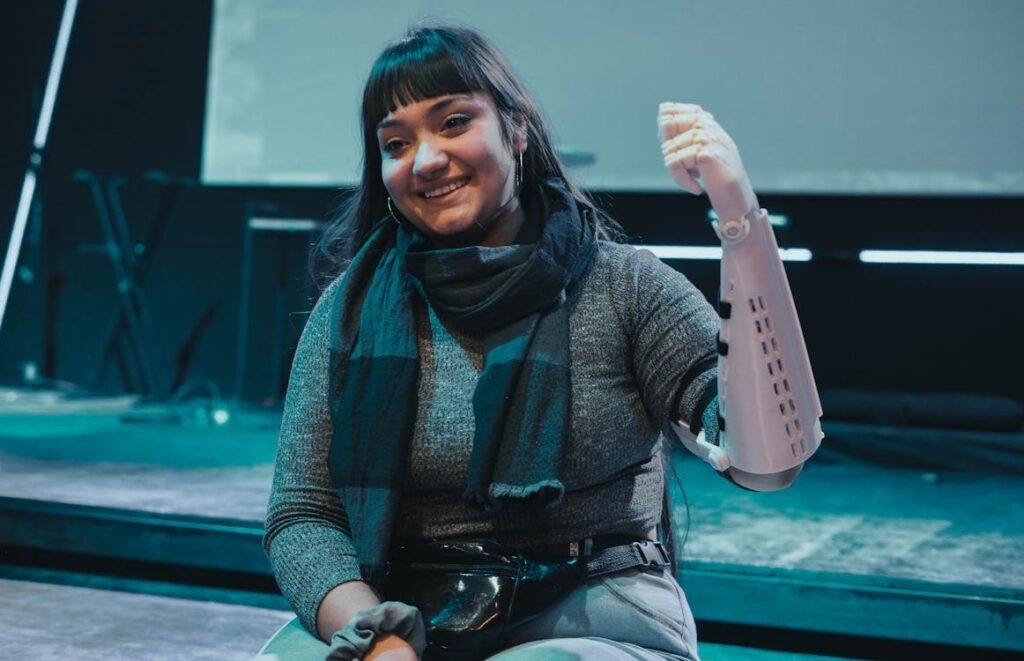
Long-Term Adaptation and Embracing Independence
Getting fitted with a prosthetic is just the beginning of the journey. Over time, your body, mind, and lifestyle will continue to adapt to this new extension of yourself.
The key to long-term success with a prosthetic is continuous learning, regular adjustments, and a positive mindset.
Building Muscle Memory and Refining Movements
The more you use your prosthetic, the more natural it will feel. This is because of a phenomenon called muscle memory, where repeated actions become automatic.
At first, you may need to think through every movement—how to open and close the hand, how to grip an object properly, how to switch between different functions.
But with enough practice, these actions become instinctive.
Many people find that incorporating their prosthetic into everyday habits helps speed up the adaptation process.
Simple tasks like stirring a drink, holding a book, or even resting your hand naturally on a surface help your body get used to the prosthetic’s weight and balance.
If you have a myoelectric hand, regularly using it for different activities helps strengthen the muscle signals that control it, making movements smoother and more precise over time.
It’s also important to challenge yourself. Once you’re comfortable with basic tasks, try new activities that push your skills further.
Whether it’s cooking, typing, playing a musical instrument, or even engaging in sports, every new experience builds confidence and refines your control.
Making Adjustments for Comfort and Function
Your prosthetic fit may need small adjustments over time. This can be due to changes in your residual limb’s shape, increased muscle strength, or simply evolving preferences.
If your prosthetic starts feeling loose, tight, or uncomfortable, visiting your prosthetist for modifications can make a big difference.
Some users find that using different types of sockets or liners helps improve comfort.
There are many materials available, from soft gel liners to breathable fabric covers, all designed to reduce pressure and friction.
Small changes like these can greatly improve how long you can comfortably wear your prosthetic each day.
At Robobionics, we provide personalized support and adjustments to help you get the most out of your prosthetic.
If you ever experience discomfort or need modifications, our specialists are here to assist you. Contact us for expert fitment support and guidance!
Emotional and Social Adaptation
Wearing a prosthetic is not just a physical change—it’s an emotional and social adjustment as well.
Many people worry about how others will react or feel self-conscious in public. These feelings are completely normal.
One of the most empowering steps you can take is to own your prosthetic with confidence.
Instead of seeing it as something that makes you different, view it as a tool that enhances your abilities.
Many people find it helpful to engage with support groups or online communities where they can connect with others who have had similar experiences.
Hearing real stories, sharing challenges, and learning from others’ successes can be incredibly motivating.
For those who feel hesitant about showing their prosthetic, starting small can help.
Wearing it around family and close friends first, then gradually using it in more public settings, can ease the transition.
Over time, you’ll realize that most people are simply curious or even inspired by your journey.
Looking Ahead: A Life of Independence
A well-fitted prosthetic does more than restore function—it opens up possibilities.
Whether you’re returning to work, taking up a hobby, or simply enjoying everyday life with more ease, the right prosthetic empowers you to live on your own terms.
Technology in prosthetics is advancing rapidly, bringing new innovations that enhance movement, grip, and even sensory feedback.
With smart prosthetics that connect to mobile apps, artificial intelligence improving functionality, and new materials making prosthetics more comfortable than ever, the future is bright.
At Robobionics, we are committed to helping every prosthetic user regain independence and confidence.
From personalized fitment to ongoing rehabilitation and support, we ensure that every step of your journey is as smooth as possible.
Explore our advanced prosthetics today and take the first step towards a more independent future!
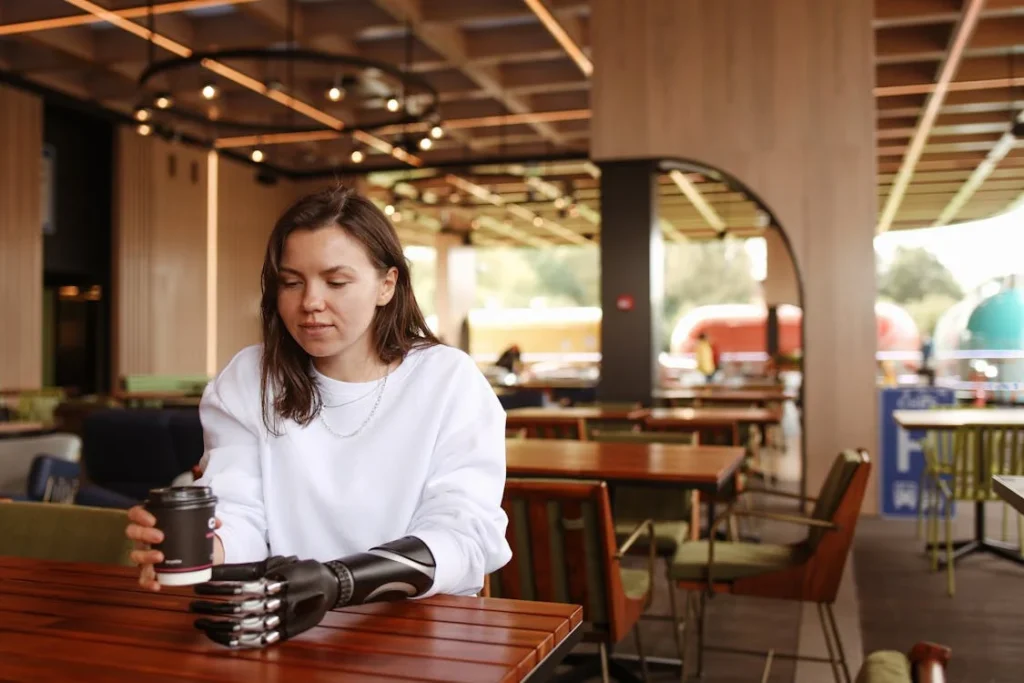
The Role of Advanced Technology in Prosthetic Fitment
Prosthetics have come a long way from simple mechanical designs to highly advanced, technology-driven solutions that offer greater functionality and comfort.
Innovations in engineering, material science, and artificial intelligence are revolutionizing the way prosthetic hands and arms are designed, fitted, and used.
Understanding how these advancements impact the fitment process can help users make informed decisions about their prosthetic journey.
Customization Through 3D Printing and Digital Scanning
One of the biggest breakthroughs in prosthetic fitment is the use of 3D printing and digital scanning.
Traditional prosthetic sockets were created using plaster molds, which could be time-consuming and sometimes inaccurate.
Now, digital scanning allows prosthetists to capture a precise model of the residual limb, ensuring a perfect fit.
These scans are then used to create custom prosthetic sockets using 3D printing, which speeds up the production process and allows for greater personalization.
3D printing also enables lightweight and ergonomic designs that improve comfort. The ability to modify designs digitally means that adjustments can be made quickly without requiring an entirely new mold.
This technology is particularly beneficial for children and young adults, as their prosthetic needs change over time.
Instead of waiting weeks for modifications, a new socket or component can be printed and fitted within days.
Smart Prosthetics and Myoelectric Technology
Myoelectric prosthetics are changing the way upper limb amputees interact with their environment.
These prosthetics use muscle signals to control movements, allowing for more intuitive and natural hand functions.
Unlike body-powered prosthetics, which require cables and harnesses, myoelectric hands operate through small sensors placed on the skin that detect muscle activity.
Recent advancements in myoelectric technology have improved responsiveness and precision.
Some prosthetic hands can now perform multiple grip patterns, allowing users to switch between different hand positions for tasks like typing, holding a phone, or picking up small objects.
These systems are designed to learn from the user’s muscle movements over time, making them more adaptive and easier to control.
The integration of artificial intelligence into prosthetics is also enhancing functionality.
Some smart prosthetics can predict the user’s intended movements based on past actions, making control more seamless.
Others can be connected to smartphone apps, allowing users to adjust grip strength, track usage patterns, and receive feedback on their progress.
Sensory Feedback and the Future of Prosthetics
One of the most exciting areas of prosthetic innovation is the development of sensory feedback systems.
Traditional prosthetic hands do not provide a sense of touch, which can make it difficult to judge how much force to apply when holding objects.
However, new research is focused on embedding sensors within prosthetic hands that send signals back to the brain, simulating the feeling of touch.
Some experimental prosthetics already offer limited sensory feedback, using vibration or electrical stimulation to provide users with information about the objects they are holding.
As this technology advances, prosthetic users may soon be able to experience a more lifelike sense of touch, improving their ability to handle delicate items and interact naturally with their environment.
The future of prosthetics is driven by a combination of biomechanics, robotics, and artificial intelligence, all working together to create more functional and personalized solutions.
The goal is not just to restore lost abilities but to enhance them, giving users more control and freedom than ever before.
At Robobionics, we stay at the forefront of these advancements to ensure that our prosthetic users receive the latest and most effective solutions.
From myoelectric technology to personalized 3D-printed designs, we are committed to making prosthetics more intuitive, comfortable, and capable.
Conclusion
The journey to getting a prosthetic hand is more than just a medical process—it’s a step toward regaining independence, confidence, and control over daily life. A well-fitted prosthetic should feel like an extension of your body, allowing you to perform everyday tasks with ease. While the adjustment period comes with challenges, patience, practice, and the right support can make all the difference.
Advancements in technology, from 3D printing to myoelectric sensors, have made prosthetics more comfortable, functional, and adaptable than ever before. With ongoing innovations, the future promises even more intuitive and responsive solutions.
At Robobionics, we are dedicated to providing high-quality, locally made prosthetics that offer comfort, reliability, and advanced functionality. From the first consultation to long-term support, we are here to guide you every step of the way.
If you’re considering a prosthetic, now is the time to take the first step. Book a free demo of Grippy™ today and experience the difference a well-fitted prosthetic can make in your life!



